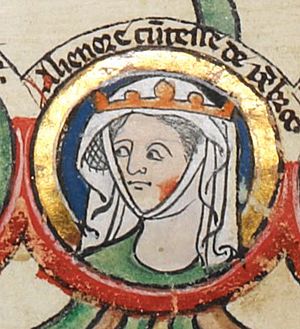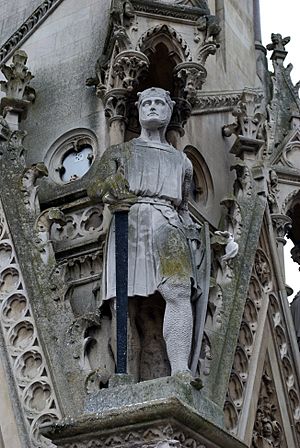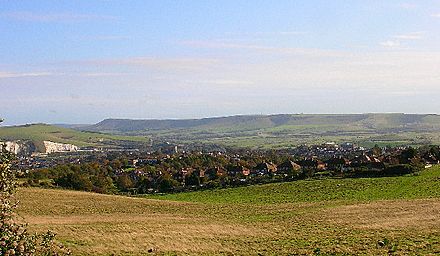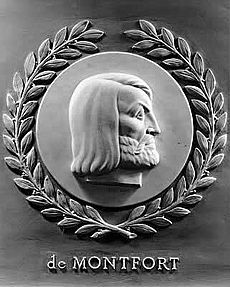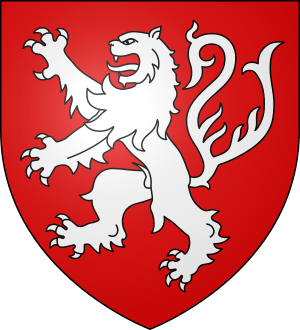Simon de Montfort, 6th Earl of Leicester facts for kids
Quick facts for kids
Simon de Montfort
|
|
|---|---|
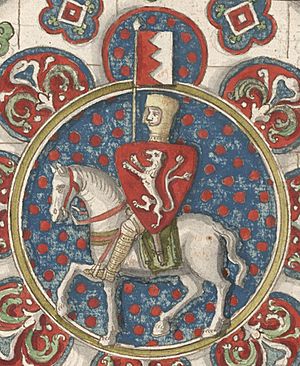
Simon de Montfort, in a drawing of a stained glass window found at Chartres Cathedral, c. 1250
|
|
| Earl of Leicester | |
| Tenure | 1239 – 4 August 1265 |
| Predecessor | Simon de Montfort, 5th Earl |
| Successor | None, title forfeit |
| Born | c. 1208 Montfort-l'Amaury |
| Died | 4 August 1265 (aged about 57) Evesham, Worcestershire |
| Buried | Evesham Abbey |
| Noble family | House of Montfort |
| Spouse(s) | Eleanor of England |
| Issue Detail |
|
| Father | Simon de Montfort, 5th Earl of Leicester |
| Mother | Alix de Montmorency |
| Occupation | Soldier and statesman |
Simon de Montfort, 6th Earl of Leicester (born around 1208 – died 4 August 1265) was a powerful nobleman. He was originally from France but became an important figure in England. Simon led a group of nobles who opposed King Henry III of England's rule. This led to a big conflict called the Second Barons' War.
After winning some early battles, Simon de Montfort became the actual ruler of England for a short time. During his rule, he made big changes to how the country was governed. He called two important meetings, known as parliaments. One of these parliaments included ordinary citizens from towns, which was a new idea. Because of this, many people see Montfort as one of the early founders of modern parliamentary democracy. Sadly, his rule lasted just over a year. He was killed by forces loyal to the king at the Battle of Evesham.
Contents
Simon de Montfort's Family Background
Simon de Montfort was a younger son. His father was also named Simon de Montfort, a French nobleman and crusader. His mother was Alix de Montmorency. Simon's grandmother, Amicia de Beaumont, was a co-heiress to the important Earldom of Leicester in England.
After the English king lost control of Normandy in France, King John did not let Simon's father become the Earl of Leicester. Instead, the title went to a cousin. Simon's older brother, Amaury, tried to get the earldom back but failed. So, he agreed that his younger brother Simon could claim it. In return, Simon gave up their family's lands in France.
Simon came to England in 1229. He spoke French, which was the language of the English court. King Henry III was friendly towards him. Simon convinced the childless Earl of Chester to give him the earldom. It took nine more years for King Henry to officially make him the Earl of Leicester.
Simon de Montfort's Life and Times
His Early Years
As a younger son, Simon de Montfort was not very well known when he was young. We don't know his exact birth date. He is first mentioned in 1217. As a boy, Simon went with his parents on his father's military campaigns. He was with his mother at the Siege of Toulouse in 1218. There, his father died after being hit by a stone. Simon also had another older brother, Guy, who died in 1220.
In 1229, Simon and his brother Amaury made a deal with King Henry. Simon gave up his rights to lands in France. Amaury gave up his rights in England. This meant Simon was free to claim the English inheritance. He received it the next year, but it took until February 1239 for him to be officially recognized as the Earl of Leicester. Simon became a favorite of King Henry III. He even used the title "Earl of Leicester" in 1236, before it was officially granted.
His Royal Marriage
In January 1238, Simon de Montfort married Eleanor of England. She was the daughter of King John and the sister of King Henry III. The king approved this marriage, but it was done secretly. Important marriages usually needed the approval of the great nobles. Eleanor had promised to remain unmarried after her first husband died. By marrying Simon, she broke this promise.
The Archbishop of Canterbury criticized the marriage. English nobles also protested because the king's sister married a foreigner who was not of very high rank. King Henry's brother, Richard, was especially angry. King Henry eventually paid Richard a large sum of money, and peace was made. This marriage brought the manor of Sutton Valence to Simon.
At first, King Henry and Simon got along well. Henry supported Simon when he went to Rome to get the Pope's approval for his marriage. Their first son was born in November 1238. He was named Henry, after his royal uncle. In February 1239, Simon officially became the Earl of Leicester. He also advised the king. He was one of the godfathers of Prince Edward, who later became King Edward I.
Expelling Jews from Leicester
As the Earl of Leicester, Simon de Montfort forced the small Jewish community to leave Leicester city in 1231. He said they could never return. He claimed this action was "for the good of my soul." His parents had also shown similar dislike towards Jewish people in France.
This action made Montfort more popular in his new lands. It removed the practice of usury, which was lending money with interest. At that time, Christians were not allowed to do this, so Jews often handled these loans. The Jews of Leicester were allowed to move to nearby areas not controlled by Montfort.
Crusade and Turning Against the King
Soon after Prince Edward's birth, Simon and King Henry had a disagreement. Simon owed a lot of money to the Queen's uncle. He had used King Henry's name as a guarantee for the repayment. The king was very angry when he found out. On August 9, 1239, Henry reportedly called Simon a "traitor" and threatened to imprison him. Simon and Eleanor fled to France.
Simon had planned to go on a crusade. He raised money and traveled to the Holy Land during the Barons' Crusade. He helped negotiate the release of Christian prisoners, including his older brother, Amaury. In 1241, he left Syria and joined King Henry's military campaign in France. This campaign failed. Simon became frustrated with King Henry.
Simon was a skilled soldier and administrator. His conflict with King Henry grew because the king ignored the unhappiness in the country. There was famine, and English nobles felt the king favored his foreign relatives too much.
In 1248, Simon planned another crusade. But King Henry asked him to stay and govern Aquitaine (Gascony) for him. Simon was strict in controlling the local lords. People complained, and Henry started an investigation. Simon was cleared of wrongdoing, but he and Henry still disagreed about money. Simon left for France in 1252. The French nobles even offered him control of their kingdom. But Simon chose to make peace with King Henry III in 1253.
He helped the king with problems in Gascony. But their peace did not last. In 1258, at the "Mad Parliament" of Oxford, Simon led the nobles who opposed the king. They formed a council of fifteen to control the government. But the king managed to divide the nobles. In 1261, Henry took back his agreement to these changes. Simon, feeling hopeless, left England.
War Against the King
Simon de Montfort returned to England in 1263. The nobles invited him back because they believed the king was against all reforms. Simon started a rebellion to bring back the government structure they had agreed upon earlier. Part of his plan was to cancel debts owed to Jewish people.
These "cancellations" often involved Simon's followers attacking Jewish communities. They seized financial records. This happened in places like Worcester and London. Simon's son, Henry, and other followers led these attacks. In London, about 500 Jewish people died. Simon's son, Simon the Younger, led another attack in Winchester. Jewish communities in Canterbury and Derby also suffered violence.
Each attack aimed to get the records of debts. These records were kept in special locked chests called 'archae'. The rebels destroyed or collected these records.
King Henry quickly gave in and let Montfort control the council. However, Henry's son, Edward, started to win over many nobles with gifts. Their disruption of parliament led to more fighting. Simon was trapped in London. He agreed to let King Louis IX of France decide their dispute. Louis, known for his fairness, completely canceled the earlier agreements in January 1264.
Civil war began almost immediately. The king's forces again trapped Simon's army in London. In May 1264, Simon marched out to fight the king. He won a great victory at the Battle of Lewes on May 14, 1264. He captured the king, Prince Edward, and the king's brother. After the battle, Montfort announced that all debts owed to Jewish people were canceled.
How He Ruled and Changed Parliament
Simon used his victory to set up a new government. King Henry remained king, but all decisions needed the approval of Simon's council. This council also had to talk with parliament. His Great Parliament of 1265 was a very important meeting.
Montfort sent requests, in the king's name, to each county and to certain towns. He asked each to send two representatives. This was not the very first elected parliament in England. But Montfort took the idea further. He included ordinary citizens from the towns, who were also elected. This was a big step for parliamentary representation. Over centuries, more towns gained the right to elect members.
His Final Battle and Death
The opposition to Montfort's government came from other nobles. The lords from the Welsh border were friends with Prince Edward. When Edward escaped in May 1265, they joined him. The biggest blow was when Gilbert de Clare, a powerful noble and Simon's ally, left him. Clare had become jealous of Simon's growing power. When Clare and his brother argued with Simon's sons, they joined Edward.
Simon's army was much smaller, even with help from his Welsh allies. Prince Edward attacked Simon's son's forces at Kenilworth, capturing more of Simon's allies. Simon himself had crossed the Severn River. He planned to meet his son, Simon the Younger. When he saw an army approaching Evesham, Simon first thought it was his son's forces. But it was Edward's army, carrying banners they had captured from Simon's allies. At that moment, Simon realized Edward had outsmarted him.
On August 4, 1265, a dark cloud hung over the field of Evesham. Montfort led his army in a desperate charge against stronger forces. One writer called it the "murder of Evesham, for battle it was none." When he heard his son Henry had been killed, Montfort said, "Then it is time to die." Before the battle, Prince Edward had chosen a group of twelve men. Their only goal was to find and kill Simon. Simon was surrounded. Roger Mortimer killed him. Simon's last words were said to be "Thank God." Other leaders of his movement were also killed.
Simon's body was buried in Evesham Abbey church. Many common people visited his grave as a holy place. But King Henry found out. He said Montfort did not deserve a holy burial. So, he had Simon's body reburied in a "secret" location, probably in the church's crypt.
Simon de Montfort's Legacy
After his death, many people visited Simon de Montfort's grave. Napoleon Bonaparte once called Simon de Montfort "one of the greatest Englishmen." Today, Montfort is mostly remembered as one of the founders of representative government.

However, Montfort is also remembered for his actions against Jewish people. Besides expelling Jews from Leicester, his followers attacked Jewish communities during the Second Barons' War. They caused harm and seized records in places like Derby, Worcester, and London. The violence against Jewish people continued even after his death. Jewish people were so afraid that King Henry had to appoint people to protect them. In 2001, the Leicester City Council formally criticized De Montfort for his actions against Jewish people.
Evesham Abbey, where Montfort was buried, was destroyed in the 1500s. In 1965, a memorial stone was placed at the site of the old altar.
Many places and organizations are named after him. De Montfort University in Leicester is named after him, as is the nearby De Montfort Hall. A statue of Montfort is on the Haymarket Memorial Clock Tower in Leicester. A carving of Montfort is also on the wall of the United States House of Representatives.
Montfort's banner, known as the "Arms of Honour of Hinckley," is used in the coat of arms of the town of Hinckley. It is also used by many local groups and the town's football club. A school and a bridge in Evesham are also named after him.
Simon de Montfort's Children
Simon de Montfort and Eleanor of England had seven children:
- Henry de Montfort (1238–1265)
- Simon de Montfort the Younger (1240–1271)
- Amaury de Montfort (1242/3–1300)
- Guy de Montfort, Count of Nola (1244–1288)
- Joanna de Montfort (born and died between 1248 and 1251)
- Richard de Montfort (died 1266)
- Eleanor de Montfort (1252–1282). She married Llywelyn ap Gruffudd, the Prince of Wales. Eleanor died in 1282 while giving birth to her daughter, Gwenllian of Wales. After Llywelyn died, King Edward I captured Gwenllian. She spent the rest of her life in a convent.
See also
 In Spanish: Simón de Montfort, VI conde de Leicester para niños
In Spanish: Simón de Montfort, VI conde de Leicester para niños
- The Song of Lewes


